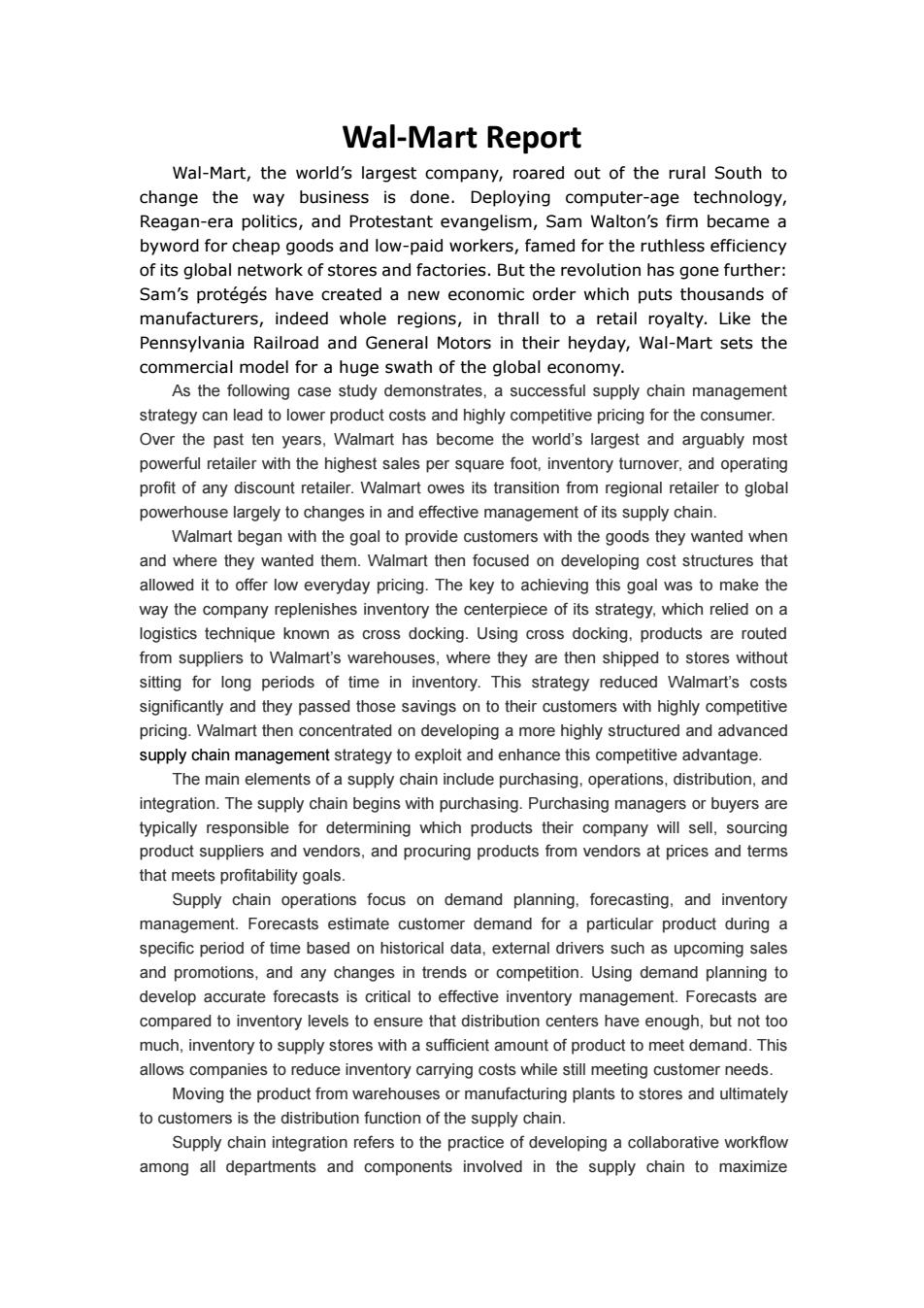正在加载图片...

Wal-Mart Report Wal-Mart,the world's largest company,roared out of the rural South to change the way business is done.Deploying computer-age technology, Reagan-era politics,and Protestant evangelism,Sam Walton's firm became a byword for cheap goods and low-paid workers,famed for the ruthless efficiency of its global network of stores and factories.But the revolution has gone further: Sam's proteges have created a new economic order which puts thousands of manufacturers,indeed whole regions,in thrall to a retail royalty.Like the Pennsylvania Railroad and General Motors in their heyday,Wal-Mart sets the commercial model for a huge swath of the global economy. As the following case study demonstrates,a successful supply chain management strategy can lead to lower product costs and highly competitive pricing for the consumer. Over the past ten years,Walmart has become the world's largest and arguably most powerful retailer with the highest sales per square foot,inventory turnover,and operating profit of any discount retailer.Walmart owes its transition from regional retailer to global powerhouse largely to changes in and effective management of its supply chain. Walmart began with the goal to provide customers with the goods they wanted when and where they wanted them.Walmart then focused on developing cost structures that allowed it to offer low everyday pricing.The key to achieving this goal was to make the way the company replenishes inventory the centerpiece of its strategy,which relied on a logistics technique known as cross docking.Using cross docking,products are routed from suppliers to Walmart's warehouses,where they are then shipped to stores without sitting for long periods of time in inventory.This strategy reduced Walmart's costs significantly and they passed those savings on to their customers with highly competitive pricing.Walmart then concentrated on developing a more highly structured and advanced supply chain management strategy to exploit and enhance this competitive advantage. The main elements of a supply chain include purchasing,operations,distribution,and integration.The supply chain begins with purchasing.Purchasing managers or buyers are typically responsible for determining which products their company will sell,sourcing product suppliers and vendors,and procuring products from vendors at prices and terms that meets profitability goals. Supply chain operations focus on demand planning,forecasting,and inventory management.Forecasts estimate customer demand for a particular product during a specific period of time based on historical data,external drivers such as upcoming sales and promotions,and any changes in trends or competition.Using demand planning to develop accurate forecasts is critical to effective inventory management.Forecasts are compared to inventory levels to ensure that distribution centers have enough,but not too much,inventory to supply stores with a sufficient amount of product to meet demand.This allows companies to reduce inventory carrying costs while still meeting customer needs. Moving the product from warehouses or manufacturing plants to stores and ultimately to customers is the distribution function of the supply chain. Supply chain integration refers to the practice of developing a collaborative workflow among all departments and components involved in the supply chain to maximizeWal-Mart Report Wal-Mart, the world’s largest company, roared out of the rural South to change the way business is done. Deploying computer-age technology, Reagan-era politics, and Protestant evangelism, Sam Walton’s firm became a byword for cheap goods and low-paid workers, famed for the ruthless efficiency of its global network of stores and factories. But the revolution has gone further: Sam’s protégés have created a new economic order which puts thousands of manufacturers, indeed whole regions, in thrall to a retail royalty. Like the Pennsylvania Railroad and General Motors in their heyday, Wal-Mart sets the commercial model for a huge swath of the global economy. As the following case study demonstrates, a successful supply chain management strategy can lead to lower product costs and highly competitive pricing for the consumer. Over the past ten years, Walmart has become the world’s largest and arguably most powerful retailer with the highest sales per square foot, inventory turnover, and operating profit of any discount retailer. Walmart owes its transition from regional retailer to global powerhouse largely to changes in and effective management of its supply chain. Walmart began with the goal to provide customers with the goods they wanted when and where they wanted them. Walmart then focused on developing cost structures that allowed it to offer low everyday pricing. The key to achieving this goal was to make the way the company replenishes inventory the centerpiece of its strategy, which relied on a logistics technique known as cross docking. Using cross docking, products are routed from suppliers to Walmart’s warehouses, where they are then shipped to stores without sitting for long periods of time in inventory. This strategy reduced Walmart’s costs significantly and they passed those savings on to their customers with highly competitive pricing. Walmart then concentrated on developing a more highly structured and advanced supply chain management strategy to exploit and enhance this competitive advantage. The main elements of a supply chain include purchasing, operations, distribution, and integration. The supply chain begins with purchasing. Purchasing managers or buyers are typically responsible for determining which products their company will sell, sourcing product suppliers and vendors, and procuring products from vendors at prices and terms that meets profitability goals. Supply chain operations focus on demand planning, forecasting, and inventory management. Forecasts estimate customer demand for a particular product during a specific period of time based on historical data, external drivers such as upcoming sales and promotions, and any changes in trends or competition. Using demand planning to develop accurate forecasts is critical to effective inventory management. Forecasts are compared to inventory levels to ensure that distribution centers have enough, but not too much, inventory to supply stores with a sufficient amount of product to meet demand. This allows companies to reduce inventory carrying costs while still meeting customer needs. Moving the product from warehouses or manufacturing plants to stores and ultimately to customers is the distribution function of the supply chain. Supply chain integration refers to the practice of developing a collaborative workflow among all departments and components involved in the supply chain to maximize